TRNSYS
TRNSYS is an extremely flexible, graphically based software environment used to simulate the behavior of transient systems. The vast majority of simulations are focused on assessing the performance of thermal and electrical energy systems.
Applications
Because of the wide user base, the tool’s long history and its inherent flexibility, it is actively being used in many of the following applications:
ENERGY BUILDING SIMULATION
SOLAR THERMAL PROCESSES
GROUND-COUPLED HEAT TRANSFER
HIGH-TEMPERATURE SOLAR APPLICATIONS
GEOTHERMAL HEAT PUMP SYSTEMS
COUPLED AIRFLOW MODELING
ENERGY SYSTEM RESEARCH
TECHNOLOGY ASSESSMENT
POWER PLANTS
HYDROGEN FUEL CELL
WIND AND PV SYSTEMS
SYSTEM CALIBRATION
Compliant with regulations
It is a reference tool for SRCC ratings in the U.S. and appears in the EU regulations for solar systems (ENV 12977-2). For applications in buildings, TRNSYS is in line with ASHRAE 140, ASHRAE 90.1 and the EU directive on energy efficiency. TRNSYS can be used for the energy credits in the LEED certification process.
Google SketchUp
Describe your building geometry in Google SketchUp, define thermal zones and import it all into to TRNSYS to run your simulations.
Video tutorials
Brief description
TRNSYS is mainly used by engineers, architects and energy consultants to design and optimize energy systems (focus on renewables and emerging efficient systems) and to design low-energy buildings.
TRNSYS is made up of two parts. The first is an engine (called the kernel) that reads and processes the input file, iteratively solves the system, determines convergence and plots system variables. The kernel also provides utilities that, among other things, determine thermophysical properties, invert matrices, perform linear regressions and interpolate external data files.
The second part of TRNSYS is an extensive library of components, each of which models the performance of one part of the system. The standard library includes approximately 150 models ranging from pumps to multi-zone buildings, wind turbines to electrolyzers, weather data processors to economics routines, and basic HVAC equipment to cutting edge emerging technologies. Models are constructed in such a way that users can modify existing components or write their own, extending the capabilities of the environment.
After 35 years of commercial availability, TRNSYS continues to be a flexible, component-based software package that accommodates the ever-changing needs of researchers and practitioners in the energy simulation community.
Comprehensive libraries
TRNSYS includes Standard Libraries with many of the components commonly found in building energy systems as well as routines to handle weather data, solar radiation processing, basic HVAC equipment, hydrogen fuel cells, solar thermal and electric technologies, thermal storage, coupling to other simulation tools and simulation results processing.
Although TRNSYS includes the Standard Library for most common energy systems, it includes a method for adding new modules, allowing users to easily modify or create new components for technologies that are not covered.
In addition to the Standard Library included in TRNSYS, users can purchase TESS libraries including more than 250 components. Each of the component libraries comes with a TRNSYS Model File (*.tmf) to use in the Simulation Studio interface, source code and an example TRNSYS Project (*.tpf) that demonstrates typical uses of the component models found in that library.
TESS Libraries represent the best of in-house types at TESS (Thermal Energy System Specialists).
OPERATING SYSTEM
TRNSYS requires Windows 95/98, NT 4.0, 2000, ME, Windows XP, Vista, Windows 7, Windows 8 or Windows 10
COMPILERS
Thanks to the drop-in DLL technology, no compiler is required to add components to TRNSYS if you obtain them as a precompiled DLL.
If you wish to debug TRNSYS or to add components for which you received the Fortran code, you will need a Fortran compiler (Please see the Programmer’s Guide for supported compilers). If you wish to create your own components, you will need a compiler capable of creating a DLL. This includes any recent Windows-compatible compiler for C++, Delphi, Fortran or other languages.
Hardware
MINIMUM CONFIGURATION
Pentium III processor or equivalent
128 MB of RAM
200 MB of available disk space (up to 2 GB if you install all the optional weather data files)
RECOMMENDED CONFIGURATION
Pentium IV processor 2.0 GHz or equivalent
512 MB of RAM
1 GB of available disk space (up to 3 GB if you install all the optional weather data files)
TRNSYS 18 Release Notes
Version 18.04.0001 (2022-22-02)
Package
Bugfix: the units of specific heat were incorrect in the Type167 (gas compressor) proforma.
Bugfix: the units.lab file formatting was fixed. Its columnation was wrong and was causing an incorrect conversion between C and K and between F and R.
Enhancement: Type103 outputs power in both W and kJ/h. The description of each output in the proformas now makes the units clear. Previously there was no way to tell the two outputs apart.
Enhancement: Some clarifications were added to the Type168 (natural ventilation) section of the 04-MathematicalReference manual.
TRNSYS Components and Kernel
Bugfix: Type1 (quadratic efficiency solar collector) could output efficiency > 100% in collector efficiency mode 2.
Bugfix: The Type1 default data file for optical mode 5 was in wrong format; proforma for optical mode 5 did not accept correct inputs for that mode.
Enhancement: new access functions getnUnits(), getIoutptVal(), getNumberOfOutputsFromUnit(), and getGlobalOutputValue(). These are necessary for TESS Type1316.
—
Version 18.03.0002 (2021-19-01)
Package
Enhancement: Revisions to the 02-SimulationStudio manual. Removal of Mathis.
Enhancement: Revisions to the Type153 and 154 sections of the 04-MathematicalReference manual. Documentation corresponds to code modifications made in v18.03.0001.
Enhancement: Revisions to the 07-ProgrammersGuide manual. Block of Type numbers newly reserved for French community TRNSYS components.
Enhancement: Revisions to A4_trnViewBUI.pdf
Enhancement: Revisions to the trnViewBUI installer.
TRNSYS Components
Bugfix: Type69.f90 – deleted unused variables in source code.
Bugfix: TrnsysFunctions.f90 – deleted blank lines in the ShowMessage() function.
Multizone Building Model
Bugfix: 301 (complex fenestration model) – wrong area was used (module area of window type instead of surface area).
Type 56 version 136
—
Version 18.03.0001 (2020-21-12)
TRNSYS Components
Bugfix: Type38 – the auxiliary heat would never turn on.
Bugfix: Type 110. corrected equation for calculating heat transfer to the ambient; added output (6) for mass balance error flag; corrected error message text on FoundBadInput errors.
Bugfix: Type153 underwent a major rewrite starting over from generic tank model, implementing auxiliary controls with one decision per timestep (ON or OFF). In prior versions of this model, auxiliary could change midway through a timestep. Mid-timestep inversion mixing was removed as well.
Bugfix: Type154 underwent a major rewrite starting over from generic tank model, implementing auxiliary controls with one decision per timestep (ON or OFF). In prior versions of this model, auxiliary could change midway through a timestep. Mid-timestep inversion mixing was removed as well.
Enhancement: Type 114. revised mass balance check to be function of convergence criteria; added output (6) for mass balance error flag.
Enhancement: Type 146. revised mass balance check to be function of convergence criteria; added output (9) for mass balance error flag; changed SSR power integral units from kJ & kJ/hr to kWh and kW.
Enhancement: Type 147. revised mass balance check to be function of convergence criteria; added output (9) for mass balance error flag; changed SSR power integral units from kJ & kJ/hr to kWh and kW.
—
Version 18.03.0000 (2020-09-12)
Package
Bugfix: corrected an error in the Type126 proforma that prevented the user from changing the value of certain parameters.
Bugfix: corrected an error in the number of data items included in the Type190.dat example inverter data file.
Bugfix: the pv_ref_params.exe tool for generating parameters for the 5-parameter PV model (Type190) had expired and has been renewed.
Enhancement: Type190 outputs power in both W and kJ/h. The description of each output in the proformas now makes the units clear. Previously there was no way to tell the two outputs apart.
Enhancement: Simulation Studio documentation updated.
TRNSYS Components
Bugfix: replaced the Type169debug.dll with the release version. The debug version of the dll was causing a Visual Studio environment crash when debugging a *.dck.
Bugfix: corrected a bug in Type47 that allowed the battery SOC to continue decreasing after discharge has stopped or to continue increasing after charging had stopeed.
Bugfix: corrected a bug that prevented the CoolProp routine from working for all fluids.
Bugfix: the v18.2 change to always rereading parameters whether or not the unit number has changed caused a problem since we were using the “”it’s time to reread parameters”” section to generate an error that only one instance of Type49 is allowed per simulation. Fixed it by storing the original unit number and comparing that to the current unit number on reread parameters. If they’re different then we error out.
Bugfix: the file Type169debug.dll caused a Visual Studio crash when debugging a simulation from the compiler. The file was replaced with the release version.
Bugfix: the getTimeStepNumber() access function no longer returns a random integer close to the present time step number but actually returns the present time step number.
Enhancement: the getParameterOfUnit() access function has been added. It returns the ith parameter of unit j.
Enhancement: the getNumberOfUnitsInDeck() access function has been added. It returns the number of UNITS in the present dck.
Enhancement: the getTypeNumberOfUnit() access function has been added. It return the TYPE number associated with a specified UNIT number.
Enhancement: added access functions to the kernel to tell a Type how many instances of that TYPE number are used in the simulation, and which instance (of the same Type) a particular UNIT is. So by calling these access functions a unit can know “there are 3 instances of this type in the simulation and the current unit is the 2nd instance in the deck”. This helps manage storage for Types that must store a large amount of data and cannot use the storage array (or prefer not to).
Enhancement: added a “ShowMessage” for Messages – it finds unit and type no by itself, and the error code is optional. The intent was to provide a more intuitive (and shorter) way to print messages.
Bugfix: The functions GEWARN, NEWARN, and EQWARN generated an error even when the “generate warning” option was selected.
Bugfix: the GTWARN function could sometimes generate a -99999 value.
Bugfix: Type119 – the total air flow rate parameter was incorrectly forced to be greater than 0.
Bugfix: Type126 (simple cooling tower) generated a floating point error if the natural convection airflow or capacity parameters were set to zero.
TRNBuild – User interface of the multizone building model
Enhancement: Improved integration of Add-On “trnViewBUI” (viewer for exploring the building/shader geometry and shading matrices)
Enhancement: output for Daylight statistic output file (NTYPE 436)
Bugfix: removed outputs 133 and 134 (outputs are used for development only)
Bugfix: generating radiance file for Daylight: shrinking of window geometry went wrong for very large values of x,y,z
Minor improvements/Bugfixes
TRNBuild version 3.0.298
Integrated tools: trnsIDF.exe v181, trnsIDFup.exe v112, trnvfm.exe v39, trnrad.exe v128, gentrn.dll v215 , trnshdbui.dll v1.0.185
Multizone Building Model
Enhancement: Code adaption to Fortran 2018
Bugfix: Outputs 170, 171 – wrong summation if more than more than one ventilation with heating/ventilation per airnode were defined.
Bugfix: TRNFlow – floating point error caused Darcy-Weisbach pipe/duct model.
Bugfix: minor changes (e.g. error messages)
Type 56 version 135
Add-ons
trnViewBUI (v1.007): additional daylight geometry is now integrated, new icon, minor bugfixes.
—
Version 18.02.0002 (2020-02-20)
TRNSYS Components and Kernel
Bugfix: the auxiliary energy in Type45 was not controlled correctly.
Bugfix: correction to the numerical precision of values placed in the parout() array for communication between dll and exe.
Multizone Building Model
Bugfix: “min. airnode volume check” may caused “fatal error” due to wrong counter for projects with multiple airnode zones.
Type 56 version 134
—
Version 18.02.0001 (2020-01-30)
Package
Bugfix: The TRNDll recompiled with correct code
—
Version 18.02.0000 (2020-01-10)
Package
Bugfix: Type110.tmf: the units of the power coefficients (parameters) are incorrectly set to kJ/h and should be dimensionless.
Bugfix: the pv_ref_params.exe tool for generating parameters for the 5-parameter PV model (Type190) had expired and has been renewed.
Bugfix: MATHIS is no longer being distributed or supported by its developer. Its proforma, documentation, and example have been removed.
Bugfix: The Type168 entry in the 05-Mathematical Reference contained an error in equation 4.6.9.2.
Bugfix: The Type168 proforma “more” button information for the mode parameter contained an error in the eqatation for ACR.
Enhancement: The Type168 documentation has been improved.
Enhancement: The Perez 1999 tilted surface radiation model that is mentioned in the documentation set (for Types15 and 99 in the MathematicalReference and for the getIncidentRadiation() subroutine in the Programmer’s Guide) now includes a reference to the paper from which it originates.
Enhancement: added a clearer hint in the Type155 (Calling MATLAB) documentation about the Type155.dll needing to match the MATLAB version being used.
Enhancement: Type56 documentation updated related to daylight and detailed humidity model(05-MultizoneBuilding.pdf)
Enhancement: trnViewBUI documentation (A4_trnViewBUI.pdf)
TRNSYS Components
Bugfix: corrected a bug in Proc.f90. When writing const and var to the *.lst file, we are only writing the first 10 characters of the array, not all the way out to the end of maxEquationLength. This can cause stray letters and partial variable names to be written to the lst file.
Bugfix: added code to avoid a division by zero in the RelativeHumidity() function in the psychrometrics routine.
Bugfix: fixed a bug in which in some rare circumstances Types could claim that they accessed an input value higher than the range they had reserved. NOTE: this change means that all Types reread the values of their parameters once per timestep. Parameters are reread from the values stored in the kernel. They are not reevaluated.
Bugfix: Type158 now does its adiabatic mixing after energy balances are computed but before outputs are set.
Bugfix: fixed a case in Type162 in which high air flow rates and low water flow rates caused a floating point error.
Bugfix: corrected a bug in Type103 that caused the cell temperature to be overestimated and therefore the power to be underestimated.
Bugfix: corrected a bug in Type190 that caused the cell temperature to be underestimated and therefore the power to be overestimated.
Bugfix: fixed a bug that caused the NaN check (part of “debugging mode”) not to work.
Bugfix: corrected an error where Type99 would occasionally increment the data field prior to correct timestep.
Enhancement: added an error check for rated condition values that result in sensible-only heat transfer and that prevent the model from being able to compute UA.
TRNBuild – User interface of the multizone building model
Enhancement: Integrated call of Add-On “trnViewBUI” for exploring the building/shader geometry and shading matrices.
Enhancement: Glazing library with update glazing systems of GlassTrösch.
Enhancement: Detailed window model: new Keywords for Window 7.7.
Minor improvements (e.g. error messages).
TRNBuild version 3.0.294
Integrated tools: trnsIDF.exe v181, trnsIDFup.exe v112, trnvfm.exe v39, trnrad.exe v127, gentrn.dll v213 , trnshdbui.dll v1.0.184.
Multizone Building Model
Bugfix: If the weather data component connected to Type 56 was “Unit 1” the automatic incident solar radiation calculation on tilted external surfaces went wrong.
Bugfix: Output 932 considered all external shading devies, not only geomteric shading devices.
Bugfix: minor changes (e.g. error messages)
Type 56 version 133
Add-ons
New: trnViewBUI – free AddOn for exploring the building/shader geometry and shading matrices.
—
Version 18.01.0001 (2018-11-26)
TRNBuild – User interface of the multizone building model
Bugfix: In the import-process of SketchUp 3D-Models, window surfaces weren’t imported correctly when their base surface names include an “e” or “E”.
—
Version 18.01.0000 (2018-11-16)
Package
Bugfix: Equation 4.9.7 14 has been corrected in the Type74 mathematical reference.
Bugfix: The Type74 proforma was corrected. The “more” button information about the axis orientation mode was incorrect.
Bugfix: modified some misleading text in the restaurant example.
Bugfix: modified the water draw profile in the SDHW example so that it is more realistic.
Enhancement: The Type74 documenation was edited to be more clear in its definitions of receiver, absorber, aperture, and reflector areas.
Enhancement: The Type74 documentation description about the possible orientations of the CPC has been improved.
Enhancement: The Type168 documentation has been clarified and improved.
Enhancement: the multizone building wizard now creates a project with line styles.
Enhancement: Revised the section in 09-Tutorials.pdf related to 3D building example and added step 6 (daylight dependent control).
TRNSYS Components
Bugfix: corrected a bug in Type15 (EPW mode) that caused a read error with certain files that don’t conform strictly to the EPW file header requirements.
Bugfix: corrected a bug in Type15 (TRY 2010 mode) that caused a read error with certain files that have a different number of header lines.
Bugfix: corrected a bug in Type103 that caused the cell temperature to be underestimated and therefore the power to be overestimated.
Bugfix: corrected a bug in Type190 that caused the cell temperature to be underestimated and therefore the power to be overestimated.
Bugfix: corrected a bug in Type156 that allowed the tank to cool below ambient if there was only a single node.
Bugfix: corrected a bug in Type158 that allowed the tank to cool below ambient if there was only a single node.
Bugfix: corrected a bug in Type9 that could cause a time inconsistency error after multiple simulation years (very small rounding errors that compound).
Bugfix: corrected the error message when Type155 fails to load in the 64-bit version.
Simulation Studio
Enhancement: Improvement in the floating license system to use emergency backup servers if the primary server is down.
TRNBuild – User interface of the multizone building model
Bugfix: Max. heat load calculation didn’t handle zones with multiple airnodes correctly.
Enhancement: import Trnsys3d file – added geosurf similar to import in Studio (Default value is 0.8 for both, previously TRNbuild used 0.6).
Minor improvements.
TRNBuild version 3.0.294; Type56 v132.
Integrated tools: trnsIDF.exe v180, trnsIDFup.exe v112, trnvfm.exe v39, trnrad.exe v126, gentrn.dll v211, trnshdbui.dll v1.0.184.
Multizone Building Model
Bugfix: output wet bulb temperature of airnode (NTYPe 180) wasn’t calculated correctly.
Bugfix: For some comfort outputs (Ntypes 121,122,123,124,125,126,127,132) the humidity calculation wasn’t switched on automatically if these were the only outputs requiring humidity calculation.
Bugfix: Shading of circumsolar radiation by external shading geometry was consider only if direct solar radiation strikes the surface. (in general, neglectable impact on results).
Type56 version 132.
—
Version 18.00.0019 (2018-06-05)
Package
Bugfix: The Type103 documentation (and proformas) refer to parameter 4 as ambient temperature at reference conditions and should have refered to it as module temperature at reference conditions.
Bugfix: The Type190 documentation (and proformas) refer to parameter 4 as ambient temperature at reference conditions and should have refered to it as module temperature at reference conditions. Note that the Type190 code was correct.
Bugfix: Made some corrections to the Type9 detailed description. The “2-hour data – averages” section contained some incorrect values.
Bugfix: corrected the location of the C++ Type template. If it is missing, exporting a proforma as C++ code caused an empty and ever growing file to be created.
TRNSYS Components
Bugfix: Corrected a bug in Type103 that asked the user for ambient temperature at reference conditions and should have asked instead for module temperature at reference conditions.
Bugfix: corrected a bug in Type29 (economics) that caused there to be no output file written.
—
Version 18.00.0018 (2018-05-18)
Package
Bugfix: The definition of “capacity” in the MathematicalReference Type107 nomenclature section has been corrected.
Bugfix: Update to the SlabOnGrade example and the Type49 documentaiton as a result of a bugfix in the code.
Bugfix: The GroundTemperatureViewer application was referenced in the SlabOnGrade example but was not included in the package. It is now included.
Bugfix: Minor improvements to the 05-MultizoneBuilding.pdf documentation.
TRNSYS Components
Bugfix: Type190 set the output power to zero if the PV array power and voltage were both above the inverter’s voltage and power limits. Type190 now limits the voltage until both voltage and power are under the limit.
Bugfix: A problem with the zone to soil heat transfer algorithm has been fixed. NOTE: this change requires the addition of one new parameter for each defined slab.
Bugfix: modified a FORMAT statement in Type40 to allow correct writing to the list file for simulations that run longer than 10 years.
Bugfix: set the Type148 outlet pressure to the inlet 1 value when there is no flow in mode 1.
Bugfix: Revision to the Type168 Rushweyh model equation for natural convection. (RuscheweyhFactor * dT**0.5 instead of (RuscheweyhFactor * dT)**0.5 )
Enhancement: Type49’s calculation speed has been improved.
Trnsys3d – 3d graphical building interface SketchUp plugin
Bugfix: Trnsys3d – TRNSYS Studio, tutorial, and faq buttons.
Bugfix: Trnsys3d – display in object info window (for SketchUp 2017 & 2018 only).
TRNBuild – User interface of the multizone building model
Bugfix: error rounding layer thickness (has to be rounded up to 3 digits).
Bugfix: for Generate Radiance files: mismatch eshade and ishade list if a constant value was defined.
Bugfix: for TRNFlow: adapted error checking such that airnodes of different zones can be linked by regime coupling.
Bugfix: for TRNFlow: wrong format for writing values of crack CSCL of Large Opening Type2 (LVO = 2) to CIF file (field width was restricted to 6).
minor improvements.
TRNBuild v3.0.292; Type56 v131.
Integrated tools: trnsIDF.exe v179, trnsIDFup.exe v112, trnvfm.exe v38, trnrad.exe v126, gentrn.dll v211, trnshdbui.dll v1.0.184.
Multizone Building Model
Enhancement: added error detection and automatic correction for incorrect link from Type99 to Input GRDREF (ground reflectance) of Type 56.
Enhancement: added error detection for incorrect link from Type109 to Input GRDREF (ground reflectance) of Type 56.
minor improvements.
—
Version 18.00.0017 (2018-01-19)
Package
Bugfix: The SunSpace.tpf (which is referenced in the Tutorials manual) is added back to the distribution.
Bugfix: The ProgrammersGuide.pdf manual is updated to reflect the change from a single subroutine (getIndcidentRadiation() ) to getHorizontalRadiation() and getTiltedRadiation().
TRNSYS Components
Bugfix: Type15 – the tilted radiation mode for horizontal radiation was fixed as mode 3. Since the horizontal radiation comes from the weather file there should not be any tilted correction to the horizontal.
Bugfix: Type90 generated an array out of bounds error if the present windspeed is higher than any of the wind speeds listed in the power curve data file.
TRNBuild – User interface of the multizone building model
Bugfix: max. heat load calculation: window types with slope = surface orientation are reset to slope = 90 because surface orientation isn’t defined in standard format)
Bugfix: Generate Radiance Files: 1. zone numbers of daylight filenames now always match zone order of *.b18 file. 2. only adjacent surfaces with FRONT definition are taking into account for non focused zones. 3. windows of an airnode must have a shader activated in order to account for shaded states defined by window type manager.
minor improvements
TRNBuild v3.0.288; Type56 v130.
Integrated tools: trnsIDF.exe v179, trnsIDFup.exe v112, trnvfm.exe v37, trnrad.exe v125, gentrn.dll v210, trnshdbui.dll v1.0.184
Simulation Studio
Bugfix: 3D building wizard – equation of IA is corrected (no impact on the building due to setting “internal calculation” for orientations)
Bugfix: Allow for projects to import links to equations more coherently
Bugfix: Automatic naming of equations no longer uses the minus ( – ) sign in the equation name.
Multizone Building Model
Bugfix: calculation AHU – add bypass function, when ambient temperature between supply air temperature and return air.
Bugfix: daylight conceptual shading – no shading activated for all external windows of a zone => shading control for daylight is “unshaded”.
Bugfix: TRNFlow – for pollutant calculation the filter data of flow controller F2 was not read correctly.
Enhancement: CFS glazing – daylight conceptual shading control : control is set.
Enhancement: CFS glazing : variables Dtop, Dbot, Dright, Dleft for shaders defined within w7.x can be used.
minor improvements.
—
Version 18.00.0016 (2017-12-04)
TypeStudio
Enhancement: TypeStudio compiled / linked Types can now pass strings back and forth to the TRNDll.
TRNSYS Components
Bugfix: corrected a bug in Type48 (regulator / inverter) that caused an error if the battery voltage went to zero. The error is now trapped and the simulation is terminated.
Bugfix: Type15 – tilted radiation corrected in Germay TRY 2017 mode.
TRNSYS Kernel
Bugfix: corrected the Type list for the CONTAM/AHU example when run in the demo version.
Enhancement: The CallProgram() routine was changed so that the called program now runs in the background.
—
Version 18.00.0015 (2017-10-31)
Package
Bugfix: parameter / input / output descriptions have been added to the Type96 documentation.
Bugfix: “more” button contents have been added to the Type96 proforma.
Bugfix: the usr_gain.lib file was missing from both the Japanese and Spanish \Building\Lib folders
Bugfix: Type62 proforma cycles had come unglued from their respective parameters. Caused a “failed to load document” error when trying to open some projects that use Type62.
Bugfix: 3D building wizard bug fix – shading device parameters are now written correctly to the deck
Bugfix: Window types in Trnsys3d template files updated to use inputs SHADE_CLOSE and SHADE_UP for internal controle and TRNSYS.h header file are updated for the v17 calling standard.
Enhancement: Examples have been cleaned up and revised.
TRNBuild – User interface of the multizone building model
Import Trnsys3d file: surface order mismatch for several windows caused error message.
Import Trnsys3d file: bugfix import of non existing zones in updated idf model.
Generate Radiance file: wrong shader material for several windows with different window types on one wall.
minor improvements.
TRNBuild v3.0.285; Type56 v129.
Integrated tools: trnsIDF.exe v078, trnsIDFup.exe v112, trnvfm.exe v37, trnrad.exe v122, gentrn.dll v210, trnshdbui.dll v1.0.184.
Simulation Studio
Bugfix: tabs in a proforma that have a variable number of items on them now appear. Previously they could disappear.
Bugfix: all tabs (parameter, input, output, etc.) are shown for components that have a plugin. Previously if a component had no parameters but did have a plugin the user had no way of launching the plugin.
Bugfix: Edit/replace will update mode if the new component has a different mode from the old one.
TRNSYS Components
Enhancement: A mode has been added to Type15 to read the German TRY 2017 format.
Bugfix: In Type 15, for German TRY files, the algorithms have been corrected to apply the temperature and humidity data from the file on the half-hour rather than on the hour.
Multizone Building Model
Bugfix: window type – window ID defined as input/schedule might cause error message related to optical standard.
Bugfix: Outputs (for CFS model only ): 317–321 bugfix related naturally ventilated gaps. 940,943,946 bugfix for internal shading with mechanically ventilated last gap going outside.
minor improvements
TypeStudio
Bugfix: TypeStudio now colorizes the ElseIf keyword.
Enhancement: Users can now drag-and-drop a workspace (.tsw) file onto the Type Studio window to load it.
Enhancement: Users can drag-and-drop any number of Fortran files (.f90, .f95, .f03) onto the window to add them to the workspace.
Enhancement: When switching back to Type Studio, any files loaded in the workspace will be reread from disk if their contents have changed. This facilitates the “edit in a real editor, compile in Type Studio” workflow because you can just alt-tab back and forth between the two and Type Studio will always compile the latest saved version of the file.
—
Version 18.00.0014 (2017-06-23)
TRNBuild – User interface of the multizone building model
Incorrect default value for CCISHADE
TRNBuild v3.0.283; Type56 v128
Integrated tools: trnsIDF.exe v075, trnsIDFup.exe v112, trnvfm.exe v37, trnrad.exe v119, gentrn.dll v209, trnshdbui.dll v1.0.184
—
Version 18.00.0013 (2017-06-13)
Package
The C++ Type template and TRNSYS.h header file are updated for the v17 calling standard.
TRNSYS Executable and Online Plotter
The online plotter was displaying different results when refreshing the plot window. (This did not effect actual simulation results.)
The command line options /n and /h both suppress the TRNSYS error dialog window.
TRNBuild – User interface of the multizone building model
minor bugfixes
TRNBuild v3.0.282; Type56 v128
Integrated tools: trnsIDF.exe v075, trnsIDFup.exe v112, trnvfm.exe v37, trnrad.exe v119, gentrn.dll v209, trnshdbui.dll v1.0.184
Simulation Studio
Bugfix to online license activation
TRNSYS Components
Using multiple Type15s in a single project with weather files from different time zones produced incorrect solar radiation values.
Type97 (CONTAM) did not check to make sure that all zone volumes are non zero.
The three letter unit codes were incorrect for Type162 inputs 6 and 7.
A new component for calling a Python script is included. Type169 calls the script directly and does not use a transfer data file as Type163 does.
—
Version 18.00.0012 (2017-05-05)
Package
documentation for Type168 is now included.
documentation for Type96 is now included.
documentation hyperlinks are now active.
—
Version 18.00.0010 (2017-04-06)
New features at a glance
Package
Documentation emphasis on learning to better use TRNSYS
Hints and Tips documentation
Parameter / Input / Output reference documentation
Integrated TRNSYS-Dedicated Fortran Type Compiler (TypeStudio)
Documented HVAC system examples
Detailed building / HVAC modeling introduction tutorial
Additional documented examples
TRNSYS-add-ons
Integrated Fortran Compiler with a dedicated interface for use with TRNSYS (TypeStudio)
TRNBuild – User interface of the multizone building model
TRNBuild Navigator extended to regime data (heating, cooling, ventilation, gains) and contructions data (layers, surfaces, windows) and schedules
Use of longer names of airnodes and zones, construction types, etc. possible
Use of small letters for names of airnodes and zones, construction types, etc. possible
Added opaque surface types (wall, floor, ceiling,roof)
Rename wall types to construction types
Updated glazing library
New schedule library
Added annual schedules
Added new gain library
New gain categories: lights, people, equipment, misc, thermal bridge
Reference area as a new parameter for each airnode
Area related definition of regime data types (heating, cooling, ventilation, gains) possible
Extended regime coupling of airnodes from 2 to 6
Added total renewable primary energy and total non-renewable primary energy for opaque layers and windows
Several new outputs (NTypes)
Description & unit for user-defined inputs.
TRNBuild v3.0.281; Type56 v128
Integrated tools: trnsIDF.exe v074, trnsIDFup.exe v112, trnvfm.exe v37, trnrad.exe v119, gentrn.dll v209, trnshdbui.dll v1.0.184
Multizone building model
Daylight depending control type
Dynamic daylight simulation for sensor points based on DaySIM
Comfort calculation extended to elevated air speed acc. ASHRAE Standard 55-2013, Appendix G
Complex fenestration model (Add-on)
Energy demand for supply air conditioning
Simulation Studio
Parametric runs
Updated 3D building project type including daylighting
Better interoperability: TMF files in XML, syle information in the deck file
Generated FORTRAN code updated for FORTRAN 90
Simplified dialogs: unused tabs are hidden, keyboard shortcuts
Improved connection window: sort variables by name, click on inbound variables first, delete key removes the selected connection, new keyboard shortcuts and map
Improved error report: opens automatically if there are errors, new design with tabs, improved filters (notice/warning/errors)
Simulation summary report activation
Numerous simplifications and bug fixes
TRNSYS Engine
Improved solar radiation interpolation
Updated psychrometric properties
Automatic report generation
New Components
8 new controller components
20 new HVAC air-side components
3 new links to other programs (Mathis, Python, CoolProp)
11 new hydronics components
2 new utility components
2 new electrical components
Only logged in customers who have purchased this product may leave a review.
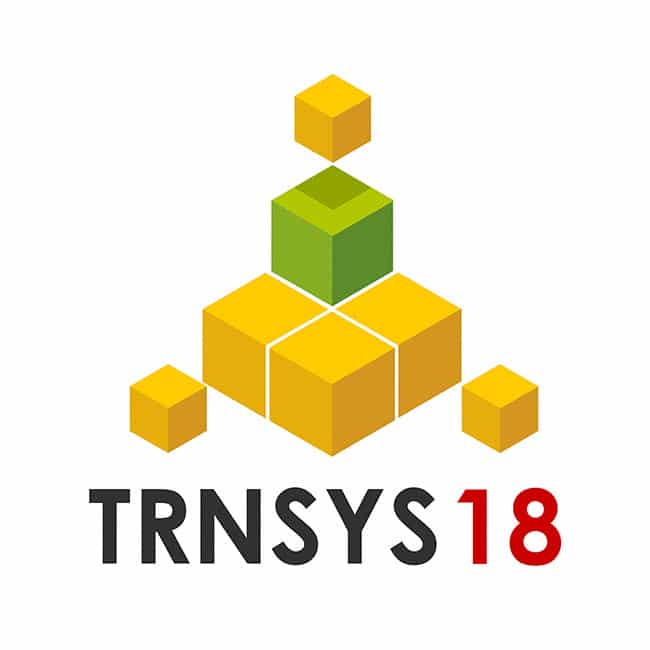
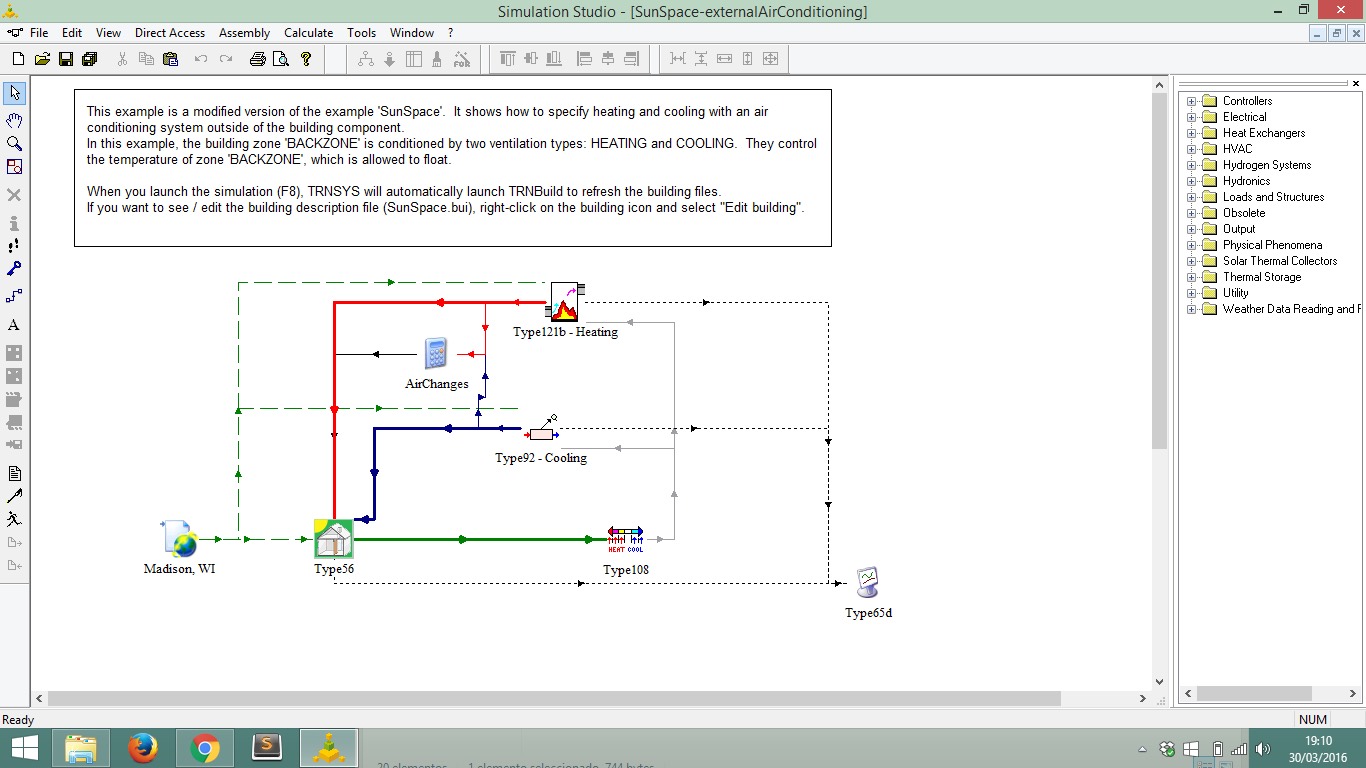
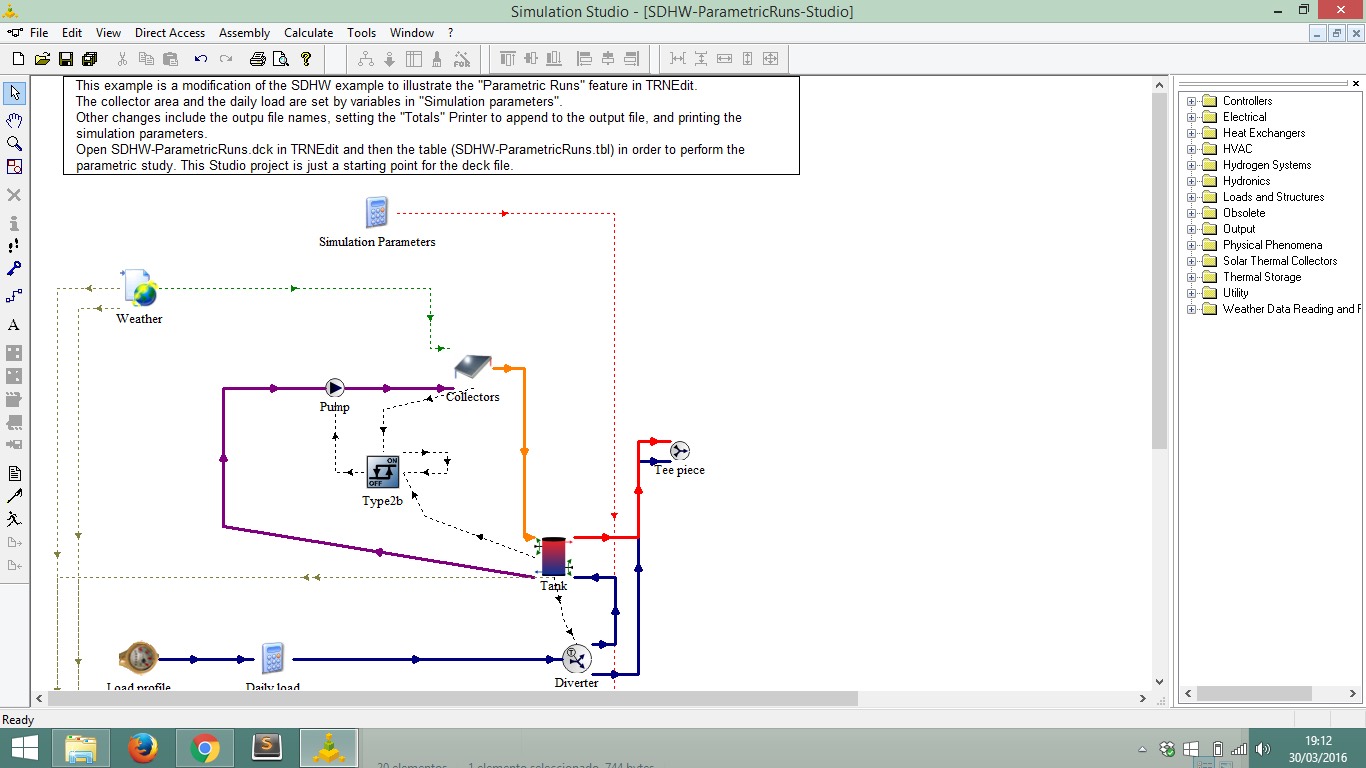

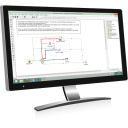











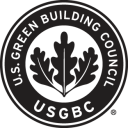
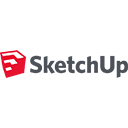


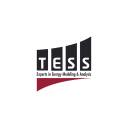


Reviews
There are no reviews yet.